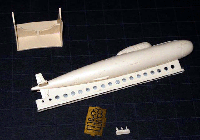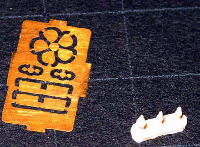
Reviewed by Vladimir Yakubov

|
One of the most unique nuclear submarine classes ever built project 705 was intended to be a submarine-interceptor. Started in 1960 the design was unique in that it was very small for a nuclear submarine - only 1500 tons, while comparable US and Soviet subs were in the 3000-5000 ton range, the hull was made from titanium and it used the liquid metal reactor for propulsion. The crew was only 32 people, mostly officers, due to a very high degree of automation employed on board. All of this made the submarine the fastest and deepest diving production submarine in the world. The maximum speed was up to 44 knots and the maximum depth was over 800m. The subs were also able to achieve the top speed in less than 1 minute. All of this combined to cause a lot of consternation in the NATO navies as the submarine was able to outrun any ASW torpedo in service at the time. This caused US and UK to introduce new torpedoes into their arsenals. Of course as with any extreme projects this performance didn't come without a price. The main drawback of the design was that it was extremely noisy. The small size of the hull didn't allow for the installation of sufficient sound dampening equipment. The second one was that the titanium hull was extremely expensive and hard to build and finally the liquid metal reactor, while extremely advanced and providing 1.5 times the efficiency of the regular water-cooled reactor, didn't allow it to be shut down or even ran at reduced power since the liquid metal would literally solidify rendering the reactor useless. In fact the first submarine of the class suffered this fate after less than 2 years in service as was scrapped. On the bright side these reactors were much safer than the water-cooled ones and they didn't release radiation in case of casualty. A total of 7 submarines of the type were built. As mentioned above, the head submarine served only two years and was scrapped. The other 6 were built to a slightly modified project 705K, through the difference were all internal. Commissioned in 1977 to 1981 all of them had a short career due to the fact that they were extremely expensive to run and the fact that NATO ASW capability quickly improved to the point where their extreme speed was no longer sufficient to protect them, while their noisiness was a very good giveaway. All but one were scrapped in 1990 during the drawdown from the Cold War, with the last being withdrawn in 1996. |
|||||||||||||
| HULL | |||||||||||||
|
The kit is very simple consisting of only 9 parts and a stand. Besides the hull, the tips of the propellers are included. The real sub was 81.4m long, which in 1/700 scale comes out to 116mm, the kit's hull measures out at 112mm and when the propeller and its tip (~3mm) are added the length becomes almost spot on. The width of the real thing was 9.5m which in 1/700 scale is 13.6mm, while the kit measures out at 13.7mm, which is perfect. Any of the 7 subs of the class can be built from the kit. The casting on the hull is good with various hatches and holes accurately modeled. There are no periscopes included in the kit, but those are better scratchbuilt anyway from brass rod, so it's not a big loss. |
|||||||||||||
 |
|||||||||||||
|
|||||||||||||
| PHOTOETCH | |||||||||||||
|
A small photoetch fret with the side fin and the screws is included.. |
 |
||||||||||||
| INSTRUCTIONS | |||||||||||||
Given the simplicity of the kit, the instructions are very good.
|
|||||||||||||
| CONCLUSIONS | |||||||||||||

This is not a first version of the Alfa on the market, but it is the most accurate one and with the other two kits being out of print you would do good in getting this one for your collection if you want an Alfa. Highly recommend it. The kit is available from Pacific Front Models for $22.00 Pacific Front Models for $22.00. |
|||||||||||||
